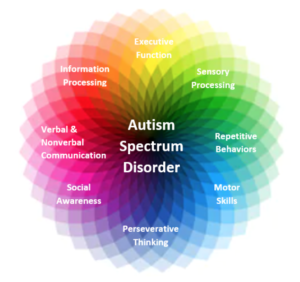Supporting Individuals with Autism in School, Work and Personal Life

Earlier this month, we talked about the significance of autism in our blog post called “World Autism Awareness Day”. We explored what autism is and its diverse characteristics. Building on that understanding, let’s now explore concrete strategies for supporting autistic individuals in various aspects of life.
Navigating life with autism spectrum disorder (ASD) can present unique challenges, but with understanding, support and patience, individuals with autism can thrive in various environments. Whether in school, the workplace or in personal relationships, there are several strategies for effectively supporting and helping someone with autism.

Understanding autism spectrum disorder (ASD)
Autism is a neurodevelopmental condition characterised by differences in communication, social interaction and behaviour. It is a spectrum disorder, meaning that it affects individuals differently and to varying degrees. Some common characteristics of autism include:
- Difficulty with social communication and interaction, such as understanding social cues and maintaining eye contact.
- Repetitive behaviours or restricted interests, such as following strict routines or focusing intensely on specific topics.
- Sensory sensitivities, such as hypersensitivity to light, sound, touch or taste.
Supporting autistic individuals in school
- Provide clear and concise instructions: Break down tasks into manageable steps and offer clear instructions to help autistic students understand expectations.
- Utilise visual aids and schedules: Visual supports, such as visual schedules, charts and diagrams, can help autistic students navigate their day and anticipate transitions.
- Foster a supportive classroom environment: Create a safe and inclusive space where autistic students feel valued and accepted. Encourage peer support and understanding through education and awareness activities.
- Implement sensory-friendly accommodations: Offer accommodations such as noise-cancelling headphones, fidget tools or designated quiet areas to help students manage sensory sensitivities.

Supporting autistic individuals in the workplace
- Provide clear communication: Offer clear and direct communication, avoiding ambiguous language or sarcasm. Be patient and willing to clarify instructions or expectations as needed.
- Offer flexibility in work arrangements: Provide options for flexible work hours, telecommuting or adjusted workspaces to accommodate sensory sensitivities and individual preferences.
- Foster a supportive workplace culture: Create an inclusive environment where diversity, including neurodiversity, is valued and respected. Offer training and education for coworkers to increase understanding and acceptance of autism.
- Provide opportunities for growth and development: Offer training, mentorship programmes and opportunities for advancement to support the professional development of autistic employees.
Supporting autistic individuals in personal relationships
- Communicate openly and directly: Be clear and straightforward in communication, avoiding ambiguous language or subtle hints. Listen actively and respectfully to the perspectives and preferences of autistic individuals.
- Respect sensory sensitivities: Be mindful of sensory triggers and provide support and accommodations when needed. Offer breaks or alternatives to overwhelming environments.
- Celebrate strengths and interests: Recognise and celebrate the unique strengths, talents and interests of autistic individuals. Find activities and hobbies that align with their preferences and abilities.
- Build strong support networks: Encourage autistic individuals to connect with supportive friends, family members or support groups who can offer understanding, empathy and encouragement.
Supporting individuals with autism requires a combination of understanding, empathy and practical strategies tailored to their specific needs and preferences. By implementing concrete support in school, the workplace and personal relationships, we can create environments where autistic individuals can thrive and reach their full potential. Let’s continue to promote acceptance, understanding and inclusion for all individuals, regardless of neurodiversity.

